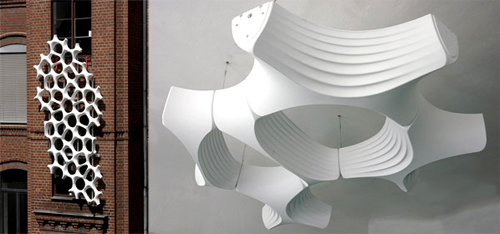The 2010 Design Triennial: Why Design Now? is open at the Smithsonian Cooper-Hewitt National Design Museum in New York. It features a pragmatic public art intervention of a different sort than the clean energy producing kind. Artwork that, all the same, can constructively lead to a more sustainable world and environment.
prosolve370e is a decorative three dimensional architectural tile that can effectively reduce air pollution in cities when installed near traffic ways or on building facades.
The tiles are coated with a superfine titanium dioxide (TiO2), a pollution-fighting technology that is activated by ambient daylight. Employing a unique configuration of this technology, the tiles neutralize air pollutants when sited near traffic or densely polluted conditions. Based on an innovative derivative of five-fold symmetries, they are assembled from only two module types to yield highly complex structures bordering on randomness. As functional ornamentation, they increase the efficacy of the photocatalytic TiO2 coating in the decomposition of air pollution. As a modification to existing architectural surfaces, prosolve370e essentially “tunes buildings” to respond better to their immediate environments.
Conceived to contrast with prevailing ideas of architecture as something immobile and permanent, the modules are fabricated with maximum material effeciency from lightweight plastics, then coated with a photocatalyst. The modules exhibited at the Cooper Hewitt use a minimum amount of material with a installed weight of only 4 kg per m2.
Some of the other works in the same exhibit showcase other interesting and creative ideas about energy design. Check them out here!

